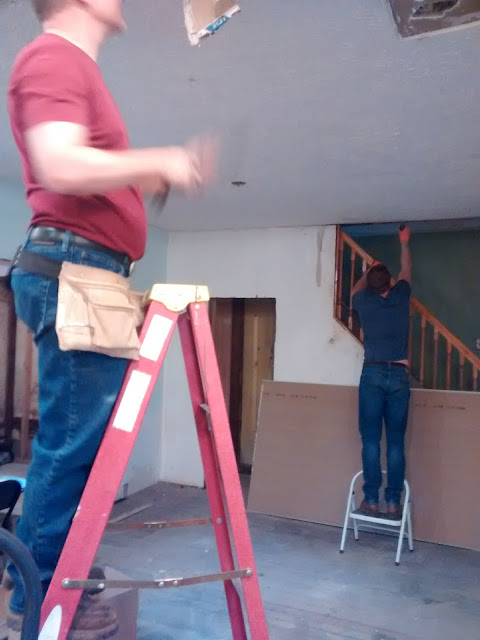Here is Kara back in the summer - she tore up all of the flooring in the front room. That doorway leads to our bedroom, which we've determined was the original dining room. First we tore off all of that green paneling.
We discovered a wall of plaster - badly cracked and painted pink. Here you can see where I've patched, but I want you to notice on the left, the outline of a door, and to the right of the actual door, the outline of another door. We believe that on the right, the existing doorway was much wider - an opening so that the front room extended into the dining room beyond. We could see clearly a bad patching job where new plaster was used to fill it in. The doorway outline visible on the left, we believe was another door into the kitchen (which will now be our master bath). My job, with the Durabond, was to go over these uneven parts in the wall and fill in, so that the wall would be smooth and so that hopefully once we paint, you won't see the old outlines of doorways!
Here I am evening out the old doorway outline on the left. You can see, in the bottom right hand part of the photo, a large crack that I filled with Durabond - a dry mix compound, that hardens after mixed with water, by a chemical process. It dries hard, like cement. It is NOT plaster, but if you wet the plaster underneath, especially broken parts inside a crack, it will seal better to the plaster. You don't want to use regular drywall joint compound to do this patching, as it won't be as hard, and it won't adhere as well to the existing plaster.
I used a 6 inch knife to do all of my patching, as well as the skim coats. I tried...and tried and tried to master a trowel. I have evidence in the closet wall that I practiced on. It's supposed to go on smoothly. When my cousin Joann saw it she said, "Oh, are you creating some kind of texture on this wall?" hahaha - so no, I didn't quite master the smooth application of an expert troweler. That is a real skill for which I have great respect.
After the patching, I knocked down all of the bumps and ridges (hey with the edge of my expensive trowel, at least I am using it still!), and applied a thin coat of joint compound with the 6 inch knife. I was pretty pleased with the first layer, but, still working on my technique, I was discouraged that I STILL laid down ridges. Joint compound is softer, so I knew I could sand, but it was bugging me. I knocked down THESE ridges, with the trowel again, and it looked pretty good, but then I did my second layer of a skimcoat, and this time I thinned the compound quite a bit. (You can't "thin" Durabond, because once the chemical process of hardening starts, it will mess this up and change the mixture - but you can thin joint compound with water, because it dries with the air, and not through a chemical change if that makes sense).
Anyway, the thinner compound was way way easier to work with, and I managed to lay down a very smooth application. I was super proud and kept telling Matt what a great job I did, haha. I do have to sand it still, but you have to look really closely to see the imperfections.
And here we are with my beautiful wall! Next I prime it, and then paint it!
Before:
After:
Fun!




























































